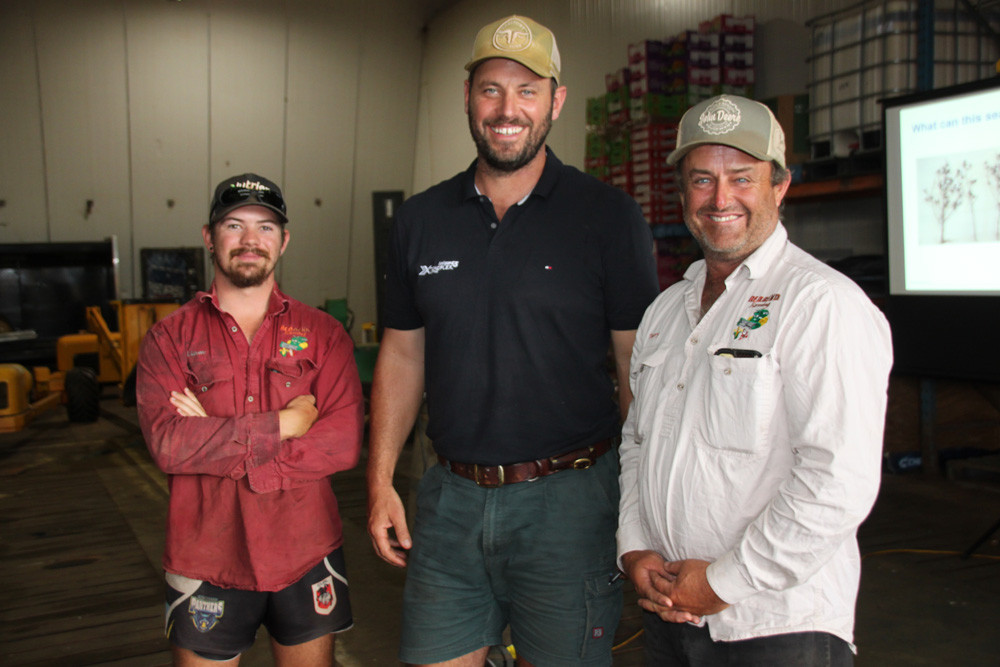On The Land
6 November, 2022
Cotton farmers prepare for next years season
Cotton growers from the Mareeba-Dimbulah district met at Toumoulin, near Ravenshoe, last week for a FNQ Sustainable Cropping Group, Research and Development Forum.

Market Development Manager with Bayer Crop Science, Dr Kristen Knight of Toowoomba, entomologist with a Ph.D. focused in Biological Control, and Tolga-based Territory Business Manager for Northern Australia, Ben Turner updated growers on their Resistance Management Plan for the 2023 season.
As the owners of the rights to cotton industry technology, such as Bollgard 3 and Roundup Ready Flex, it falls under Bayer's stewardship to educate new growers in their Resistance Management Plans (RMP).
With Bollgard 4 still 10 years away, they must ensure growers abide by the plan to safeguard the industry against the development of pest and disease resistance in the interim.
Bollgard 3 is genetically modified cotton that has been grown in Australia since 1996. It contains three naturally occurring insecticidal proteins toxic to the crop's main predator, Helicoverpa spp. Since its introduction, herbicide applications have dropped from up to 22 applications in a season in the 1980's to 0-3 treatments per crop since 1992.
In addition to reduced usage of residual herbicides and soil tillage, resulting in less chemical runoff and soil erosion, the populations of beneficial insects and wildlife have increased and since 2010, an income gain of around $180/ha has been delivered to farmers.
The Resistance Management Plan is based on three main principles - firstly minimising the exposure window of the Helicoverpa spp moth to the protein stack in the Bollgard 3 plant.
Secondly, providing a population of susceptible moths that can mate with any resistant individuals, diluting the formation of any potential resistance and finally, removing any resistant insects at the end of the cotton season.
Those three principles are supported by five key elements, including planting timing restrictions; planting adequate refuge crops; control of volunteer and ratoon cotton; pupae destruction in trap crops and the limitation of sprays around refuge crops.
Planting windows in the unique, low latitude/high altitude Far North Queensland zone, which stretches from Mutchilba to the Mt Garnet area, have been pared back to an 8-week period from 3 December to 15 January to catch the best of the Northern solar radiation.
For each Bollgard 3 crop planted, a grower is required to plant an unsprayed breeding area for moths, (refuge crop), five per cent of the size of the main crop to help control resistance.
The refuge area supplies a source of wild-type (non-mutant) insects to mate with possible resistant insects to produce nonresistant moths that will be affected by the crop proteins.
Refuge crops should be planted into fallow or rotation fields 2 weeks prior to planting Bollgard 3 and managed so that they are attractive to Helicoverpa spp, flowering at the same time as the Bollgard crop.
Growth of "volunteer" cotton occurs where plants regrow from cotton trash that has been left on the ground and "ratoon" cotton occurs where the cotton plant has survived the winter and regrows from old root stock.
This rogue cotton hosts pests and diseases, diminishes the value of the refuge crop and competes with other crops, causing a huge weed problem, so they must be removed prior to flowering.
Trap crops are an organic pest control method where sacrificial plants are grown to attract invading pests away from the main crop, offering them a place to feed and breed.
Within 2-4 weeks of the cotton being harvested, growers of Bollgard 3 must undertake Helicoverpa spp pupae destruction above and below ground - slashing and discing - to annihilate the population and further mitigate the risk of resistance.
Sprayed crops and unsprayed refuges that are planted in adjacent fields must be separated by sufficient distance to minimise the likelihood of insecticide drift onto refuge areas.
Principal Research Scientist- Entomology and Farming Systems at DAFFQ, Toowoomba, Paul Grundy then led a discussion on the difference of growing cotton in the tropics compared to southern and central Queensland .
Essentially it come down to optomising photosynthesis and canopy and nitrogen management to avoid crop loss.
Cotton is a high energy product, but its biomass production from energy is low, only half that of corn and sugar. Its development is driven by temperature (accumulated heat units), so basically "the more sun the better."
A temperature range of 20 degree minimum to a 30 degree max-imum is ideal for optimum growth efficiency. Cloudy weather can cause periods of insufficient growth causing plants to shed flowers or throw fruit or undersize bolls to the ground.
The north's extremely variable climatic conditions and the crop's need for 13-23 Megajoules of solar radiation per day, pre-sent the greatest single challenge to the success of this important, emerging industry.
Ironically, while most farmers are focused on getting adequate rainfall, successfully establishing their crops and eradicating insect populations, cotton growers are operating in reverse.
They need sustained levels of sunshine, are growing their own predatory insect groups within their cropping system and find that the destruction of their crops post-harvest and outside designated growing areas, one of their most difficult tasks.


